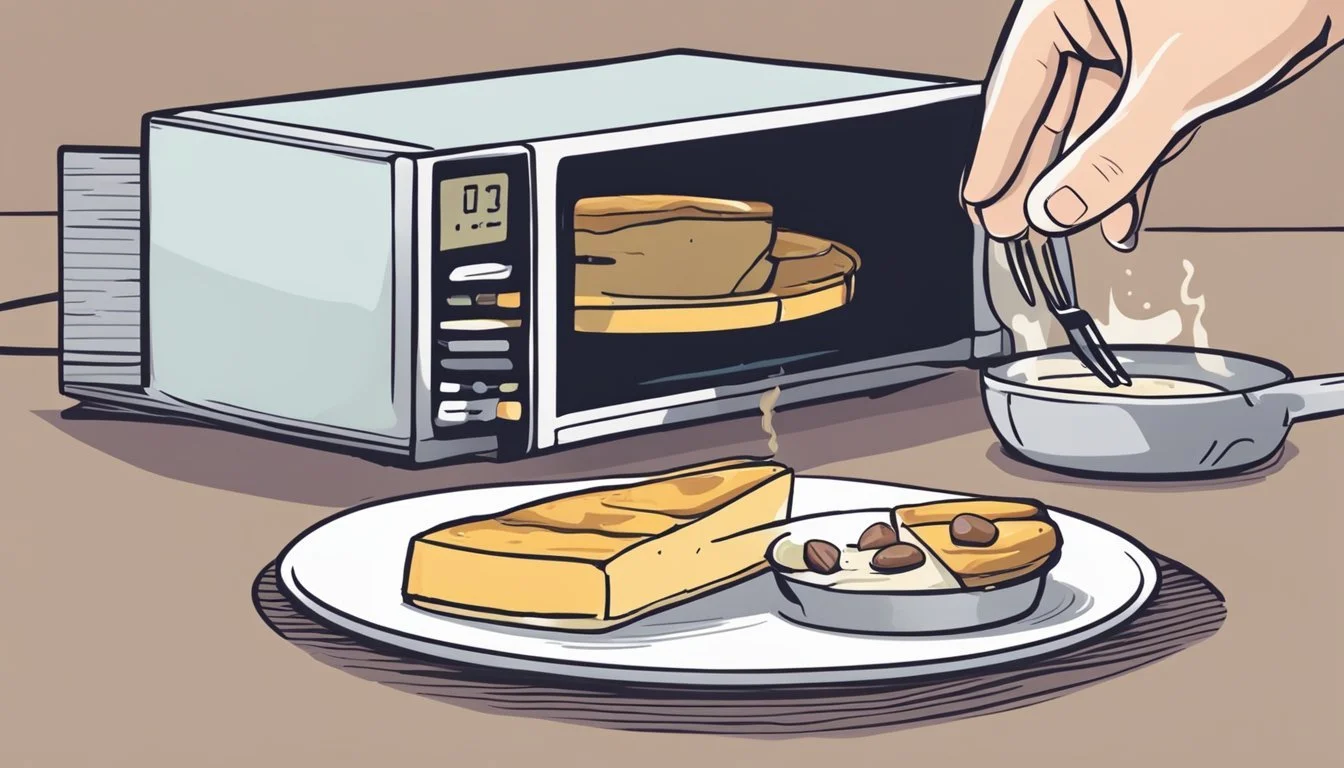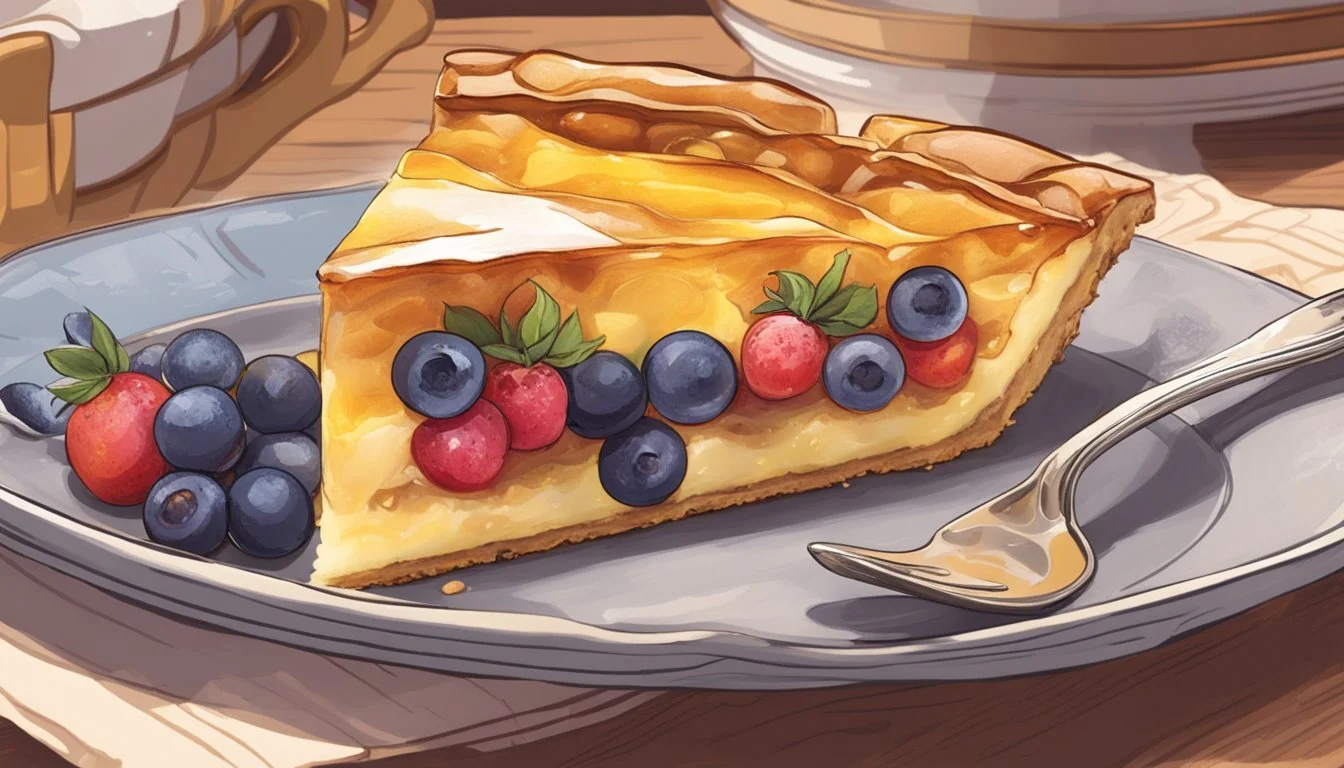How to Reheat Clafoutis
Tips for Perfectly Warmed French Desserts
Reheating clafoutis can be a delicate task that ensures this traditional French dessert retains its delightful texture and flavor. Originating from the Limousin region, clafoutis combines a custard-like batter with fresh cherries, creating a dessert that's rich and aromatic. When reheated improperly, however, the custard can turn rubbery or the cherries may lose their vibrant taste.
To reheat clafoutis effectively, use an oven preheated to a low temperature of around 275°F (135°C). Place the clafoutis in an oven-safe dish, cover it loosely with foil to prevent drying, and warm it for about 10-15 minutes. Alternatively, if you're in a hurry, reheating at a higher temperature of 350°F (180°C) for a shorter period can work, but be cautious to check the texture frequently.
Before reheating, let the clafoutis reach room temperature, especially if it was refrigerated. Allowing it to sit out for 20-30 minutes ensures even warming throughout. By following these steps, you can enjoy clafoutis as if it were freshly made, savoring every bite of this delightful French custard and cherry dessert.
Understanding Clafoutis
Clafoutis is a classic French dessert that traditionally features cherries baked in a custard-like batter.
Cherries play a vital role, offering a juicy and slightly tart contrast to the sweet custard. They are typically used whole, with pits, to maintain their shape and flavor.
The batter consists of simple ingredients: eggs, milk, sugar, flour, and vanilla extract. These staples combine to create the dessert's signature custardy texture.
Preparation is straightforward. The cherries are spread evenly in a buttered dish, and the batter is poured over them. The bake process occurs at a moderate temperature, commonly around 350°F (175°C).
This dessert is celebrated for its simple and versatile nature, making it a popular choice for both family meals and dinner parties. It harmonizes the richness of the custard with the freshness of the fruit.
The custard-like texture of clafoutis is a result of the egg and milk mixture, which sets around the fruit during the baking process. Served warm or at room temperature, clafoutis showcases the elegant simplicity of French culinary traditions.
Components of Clafoutis
Clafoutis is a delightful French dessert known for its rich, custardy texture. It consists of a few essential components: the choice of fruit, the clafoutis batter, and sweetening agents. Each element plays a key role in creating the perfect dessert.
Fruit Variations
The most traditional clafoutis is made with fresh, pitted black cherries. These cherries provide a classic flavor and are often preferred due to their natural sweetness and juiciness. However, other fruits can be used to create delicious variations of this dessert. Berries like blackberries, raspberries, and blueberries add a tangy twist.
Apples, pears, plums, and apricots are also excellent choices, lending different textures and flavors. When using soft fruits, ensure they're evenly spread in the baking dish to ensure consistency.
Clafoutis Batter
The clafoutis batter is a simple mix, yet it is crucial for achieving the dish's rich, custardy texture. Key ingredients include eggs, whole milk, and cream. The batter is thickened with all-purpose flour and enhanced with a pinch of salt. This base creates the silky consistency that clafoutis is known for.
Adding almond extract and vanilla elevates the taste, providing subtle and aromatic notes. The batter should be smooth and lump-free for the best result, ensuring an even bake and cohesive texture.
Sweetening Agents
Sweetening clafoutis involves a balance between granulated sugar for the batter and options for topping. Granulated sugar is mixed into the batter, imparting sweetness that melds with the custard base. Depending on the type of fruit used, adjusting the amount of sugar can optimize taste.
For garnishing, powdered or confectioners’ sugar is often dusted over the top before serving. This not only enhances sweetness but also adds to the visual appeal. To cater to different tastes, the quantity of sugar can be modified, ensuring the dessert is not overly sweet but pleasantly balanced.
Preparation Tips
Proper preparation ensures that your clafoutis turns out perfect each time. Focusing on selecting the right ingredients and creating a smooth batter is essential.
Selecting the Right Ingredients
To achieve the best clafoutis, it is crucial to use fresh, high-quality ingredients. Whole milk is recommended for its rich, creamy texture. Unsalted butter allows you to control the salt content in the dish.
Quality vanilla extract adds a depth of flavor that complements the cherries. Always choose freshly pitted cherries, as they provide the most natural sweetness and texture.
Select an oven-safe baking dish to ensure even cooking. The choice of dish impacts the final texture and browning of the clafoutis.
Creating the Perfect Batter
The key to a smooth clafoutis batter is thorough mixing. It is best to blend or whisk the ingredients until you achieve a smooth texture without lumps.
Whole milk ensures a creamy consistency, while unsalted butter adds richness. Start by mixing the wet ingredients, then gradually incorporate the dry components.
Ensure that the batter is smooth and lump-free before pouring it into your prepared baking dish. The goal is to achieve a golden brown finish and even texture as it bakes.
Reheating Techniques
Reheating clafoutis involves several methods that maintain its delicious texture and flavor. Different techniques cater to various preferences for convenience or preservation of quality.
Oven Reheating
Reheating clafoutis in the oven is ideal for preserving its original texture and flavor. Preheat the oven to a low temperature, around 275°F (135°C). Place the clafoutis in an oven-safe dish and cover it loosely with foil to prevent drying out. Warm it for 10-15 minutes, checking occasionally to avoid overcooking. This method ensures a custardy texture and a slight golden brown finish that resembles the freshly baked dish.
Microwave Reheating
For a quicker option, the microwave offers speed and convenience. Place a slice of clafoutis on a microwave-safe plate. Cover it with a microwave-safe lid or a damp paper towel to retain moisture. Heat on medium power for 20-30 seconds. Check the temperature and continue in 10-second intervals if needed. While this method is faster, it may slightly alter the dessert's texture, making it less ideal for those who prioritize the original custardy texture.
Alternative Reheating Methods
Other methods include using a toaster oven or a stove. For the toaster oven, follow similar steps to the oven method with a cook time of 8-12 minutes. On the stove, use a non-stick pan on low heat, covering the clafoutis and flipping it occasionally until warmed through. These methods are useful for small portions or when a conventional oven or microwave is not available. They offer flexibility, ensuring that leftovers remain delicious for any meal, be it brunch, a dinner party, or a family gathering.
Serving Suggestions
Warm clafoutis serves beautifully as a dessert or a sweet addition to a brunch or breakfast meal.
Top the clafoutis with a dollop of whipped cream for added richness. It pairs perfectly with the soft, custard-like texture of the dish.
Sprinkle a light dusting of powdered sugar over the top for a touch of elegance.
Include fresh berries or a sprig of mint as a garnish to enhance the presentation.
Serve slices on individual plates and accompany with a side of vanilla ice cream for an extra indulgence.
Proper Clafoutis Storage
Storage is essential for maintaining the freshness of clafoutis. When it comes to leftover clafoutis, it is best to store it in the fridge. To do this, cover the dish with aluminum foil or plastic wrap. This will help the dessert retain its texture and flavor.
Refrigerate the clafoutis within two hours of baking. It can be kept in the refrigerator for up to three days. This helps preserve the custard-like batter and prevents spoilage.
Avoid freezing clafoutis. The custard-like batter does not freeze well, often resulting in a watery and grainy texture upon thawing. If freezing is necessary, use an airtight container and wrap it well to minimize texture changes.
When ready to eat, remember proper reheating techniques. Preheat the oven to 325°F (165°C) and cover the clafoutis with aluminum foil to prevent it from drying out. Heat until just warmed through, typically 10 minutes.
For a quick reheat of individual slices, the microwave can be used as a last resort. Heat on low power in short intervals to avoid cooking the custard further.
Health and Nutrition
Clafoutis, a traditional French dessert, is not only delicious but also includes several nutritious ingredients.
Cherries, the star of clafoutis, are a rich source of vitamins A and C, antioxidants, and dietary fiber. These nutrients contribute to overall health and well-being.
The main batter ingredients—eggs, milk, and flour—offer essential nutrients. Eggs are a great source of high-quality protein, vitamins, and minerals. Milk provides calcium, protein, and vitamin D, while flour adds carbohydrates necessary for energy.
A typical serving of clafoutis can contain around 200-300 calories, depending on the recipe and portion size. The sugar content can vary, though clafoutis usually contain moderate to high amounts to balance the tartness of the cherries.
Some recipes include heavy cream, which increases the calorie and fat content. Opting for lower-fat alternatives can make the dessert lighter.
In terms of dietary preferences, clafoutis is relatively easy to adjust. It can be made gluten-free by using alternative flours, or dairy-free by substituting plant-based milk.
For those hosting a family dinner or a dinner party, clafoutis makes an excellent choice. Its simple and custard-like base, enriched with cherries, will please guests while also providing nutritional benefits.
Flavor Enhancements
Enhancing the flavor of clafoutis can elevate this delightful French dessert to new heights. There are several ways to add depth and complexity to the dish, catering to various tastes.
Incorporating rum, kirsch, or cognac can introduce a rich, aromatic element to the clafoutis. These spirits blend seamlessly with the custardy base and juicy cherries, imparting subtle, sophisticated notes.
For those who prefer non-alcoholic options, an extra teaspoon of vanilla extract can enhance the sweet, creamy flavors.
Almond flavor can be introduced by adding almond extract or using ground almonds in the batter. This element complements the cherries wonderfully, creating a harmonious blend.
When using sweet cherries, ensuring they are ripe and juicy will maximize the fruit's natural sweetness and enhance the overall taste. Fresh, high-quality cherries are ideal for the best results.
As a finishing touch, garnish the clafoutis with a dusting of powdered sugar or toasted nuts. These garnishes not only add visual appeal but also introduce additional textures and flavors.
By experimenting with these elements, one can create a clafoutis that is not only delicious but also uniquely personal.







